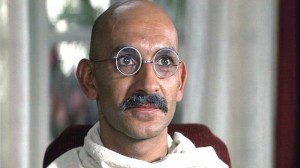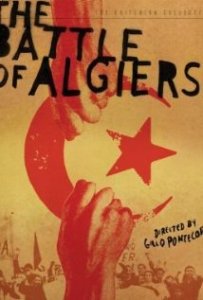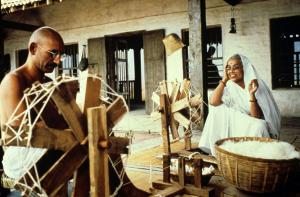Over winter break, out of boredom, and being the history buff that I am, I decided to watch two films on colonial struggles: the first, “Gandhi” (1982), is an Academy Award winning film that depicted the Indian leader’s life and works in its historical contexts. (In fact, it completely dominated the Academy Awards ceremony in 1983, it won 8 out of the 11 awards it got nominated for, including Best picture, Best Director, and Best Actor (Ben Kingsley). The second film I watched is the “Battle of Algiers” (1966), it’s original title is “La battaglia di Algeri” in Italian. It is shot in black and white in newsreel formatting, and depicts the collectivist struggles for freedom by a guerrilla group based in the city of Algiers in Algeria. The two films could not have been more different. For the purpose of this blog, I will talk mostly about “Gandhi” and compare it with the “Battle of Algiers” briefly.

“Gandhi” was directed by Richard Attenborough, and is a notable biographical film based on the life and work of Mohandas Gandhi, the spiritual leader of India that led the nation towards freedom. In examining this film, we must place the film in the context of colonialism, examining the film as work of history and a biopic, and look at individual elements of the film.
Firstly, even though “Gandhi” is a work of fiction about the life of a man, it is also the struggles of a nation embodied in the life of one its most beloved figures. Indeed, the life of Gandhi is closely tied to his struggles through non-violent means to end colonialism in India. From the 17th century, the British began to gradually dominate the Indian subcontinent through the British East India Company; after the Indian Mutiny in 1857, India became directly administered by the British government as the British Raj. In time, the British began to educate a group of Indians of the upper castes, men like Gandhi, to serve as educated leaders of India. Nevertheless, the British did not materially advance the well-being of the average Indian during this time period, and Indian economy stagnated during the centuries of British rule.
It is against this backdrop of colonialism and exploitation that Gandhi came to the forefront. In many ways Gandhi is the type of Indian that is destined to be successful in the colonial framework: born in the Bania (Merchant) caste, his family is well-to-do and he was trained in England to become a lawyer. However, as depicted in the film, he was made painfully aware of the inequalities faced by Indian subjects of the British Empire when he encountered racism on a train in South Africa when he was 23. The film depicts this as the beginning of Gandhi’s non-violent resistance to enact changes in society, and his decision to fight against injustice not with a sword but through acts of resistance against what he sees as unjust laws. Gandhi later returned to India in 1914, and in association with other prominent Indians, continued the struggles for rights of Indians, this time in their home country. The film depicted the struggles that Gandhi faced as a member (and leader) of the Indian National Congress, frequently jailed for his beliefs by the British; as well as his struggles he faced with other members of the Indian resistance movement, some of whom pushed for more violent means to achieve freedom. However, despite such pressures, Gandhi held fast to his belief of “Satyagraha”, using “soul-force” to overcome injustice. The film’s nonviolent themes is in contrast to other colonial struggles of the time, most notably to the struggles against colonialism in French Algeria as depicted in “Battle of Algiers”. The two films are similar in using the theme of anticolonial struggles; but while “Gandhi” is a treatment of anti-colonialism through the life of a single individual, “Battle of Algiers” lacked such a definitive figure and is instead portrayed as a collectivist struggle, led by the National Liberation Front (in French, “Front de Libération Nationale”, or FLN). The violence accompanying the Battle of Algiers is all the more shocking when compared to Gandhi’s lifelong struggle against any such violent acts. However, as one of leaders in Battle of Algiers pointed out “Acts of violence don’t win wars. Neither wars nor revolutions. Terrorism is useful as a start. But then, the people themselves must act.” Perhaps, in end, the two messages in the films are similar: a revolt against colonialism must be a mass movement that takes to heart the needs and wants of the people it is trying to serve.
Given the film’s focus on Gandhi and his struggles for Indian independence, we must then examine the film through two different lens: as a work of historical drama in the traditional sense and as work of biopic. This movie is a traditional historical drama, a dramatic feature film. The individual is the focus of these kind of historical dram films, and the film tries to make the viewer see, hear but above all to feel what is happening on screen. When Gandhi is pleading with Jinnah, the leader of the Muslim League, urging the Muslims and Hindu to become united in post-independent India, we can feel his pain as his life-long dream of religious diversity in India is being shattered. A traditional historical drama uses all the standard conventions of plot elements, and tells the story to elicit a response from the viewer; “Gandhi” does all of these and it succeeded in telling us the story. As a work of biopic, Gandhi can best be classified as a “serious biofilm”, as the director have tried to follow the history as closely as possible instead of merely use history as a backdrop for certain events. We must bear in mind the director is under severe time constraint (in the span of a few hours) to cover the essential elements of Gandhi’s life and as such the film may seem crammed and overly dramatic at times, but that is not the purpose of the film.
Finally, a film like Gandhi is without its critics, especially with regard to its factual accuracies. For instance, the film depicts Gandhi as completely innocent and naïve on the train in South Africa in 1897, refusing to leave the first class carriage when he was asked to. It is not very believable that Gandhi is so “ill-informed about the racial code of South Africa”. However, despite such mild inaccuracies, the overall direction of the film had the factual accuracies in mind, and the director meant for every event in the movie to be important and to collectively present to the viewer the image of Gandhi as truthfully as possible. Moreover, the film did not deliberately distort fact to suit its purpose, and taken as a whole, the film is a great work, both as a work of history and a biography. In any case, “Gandhi” is a great film to watch, and if you have time, please watch “Battle of Algiers” as well, just so gain a better understanding of what colonial struggles is all about.
